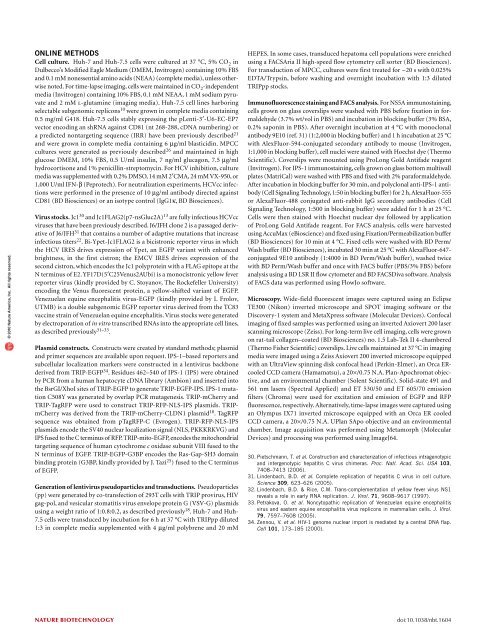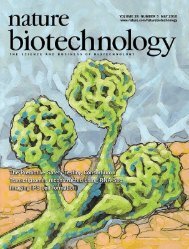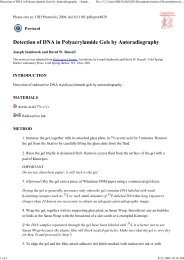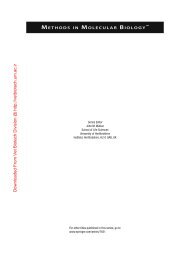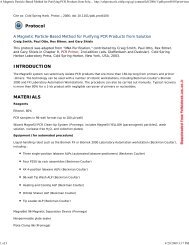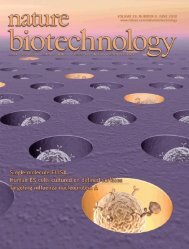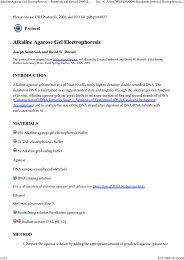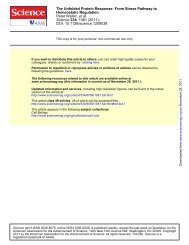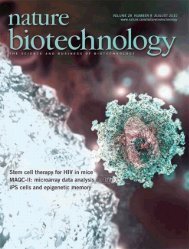l e t t e r s© 2010 Nature America, Inc. All rights reserved.HCVcc to infect biologically relevant primary cell types may also be keyto understanding authentic viral processes and patient-specific responses.The low level of replication observed in these cultures may reflectheterogeneity between individual cells or viral genomes, and underscoresthe value of single-cell analysis in dissecting the often subtle or variablephenotypes associated with chronic infection. Combining HDFR-basedvisualization with laser capture microscopy and analysis of neighboringinfected and uninfected cells could begin to unravel the determinants ofpathogenesis or virus control. The value of single-cell analysis was furtherillustrated by multiplexing HCV detection with a fluorescent marker ofcellular stress, allowing direct visual correlation of viral and host events.Recent advances in automated microscopy and ‘high-content’ screeninghave made a large number of cellular phenotypes, including drugtoxicity profiles, accessible to interrogation in a multiparametric format(reviewed in ref. 29). Addition of a robust fluorescent translocation assayrequiring minimal sample processing has the potential to integrate HCVresearch into this burgeoning field. We anticipate that the ability of HDFRto increase the flexibility and diversity of HCV culture systems will beimportant for basic virology and antiviral drug development.MethodsMethods and any associated references are available in the online versionof the paper at http://www.nature.com/naturebiotechnology/.Note: Supplementary information is available on the Nature Biotechnology website.AcknowledgmentsWe acknowledge the expert support of The Rockefeller University BioimagingCore Facility, with special thanks to A. North, S. Galdeen and S. Bhuvanendran.We thank The Rockefeller University Flow Cytometry Resource Center, supportedby the Empire State Stem Cell Fund through NY State Department of Health(NYSDOH) contract no. C023046; opinions expressed here are solely those of theauthors and do not necessarily reflect those of the Empire State Stem Cell Fund,the NYSDOH, or the State of NY. We are grateful to C. Stoyanov (The RockefellerUniversity) for YF17D(5′C25Venus2AUbi), J. Tazi for G3BP (Institut de GénétiqueMoléculaire de Montpellier) and I. Frolov (UTMB) for Venezuelan equineencephalitis virus-EGFP. We thank M. Holz, A. Forest, M. Panis and A. Websonfor laboratory support and C. Murray for critical reading of the manuscript. Thiswork was supported by Public Health Service grants R01 AI075099 (C.M.R.)and R01 DK56966 (S.N.B.). This work was also funded by the Office of theDirector/National Institutes of Health (NIH) through the NIH Roadmap forMedical Research, Grant 1 R01 DK085713-01 (C.M.R. and S.N.B.). Informationon this Roadmap Transformative R01 Program can be found at http://grants.nih.gov/grants/guide/rfa-files/RFA-RM-08-029.html. Additional funding was providedby the Greenberg Medical Research Institute and the Starr Foundation (C.M.R.).S.N.B. is an Howard Hughes Medical Investigator investigator. C.T.J. was supportedby National Research Service Award DK081193; M.T.C. was supported by a Women& Science Fellowship; L.M.J.L. is supported by a Natural Sciences and EngineeringResearch Council of Canada fellowship. A.P. is a recipient of a Kimberly Lawrence-Netter cancer research discovery fund award.AUTHOR CONTRIBUTIONSC.T.J. and C.M.R. designed the project, analyzed results and wrote the manuscript.C.T.J., M.T.C., L.M.J.L., A.J.S., S.R.K., T.S.O., A.P. and J.W.S. performed theexperimental work. S.R.K., J.W.S., T.S.O., M.R.M. and S.N.B. contributed reagentsand technical expertise.COMPETING INTERESTS STATEMENTThe authors declare competing financial interests: details accompany the full-textHTML version of the paper at http://www.nature.com/naturebiotechnology/.Published online at http://www.nature.com/naturebiotechnology/.Reprints and permissions information is available online at http://npg.nature.com/reprintsandpermissions/.1. Shepard, C.W., Finelli, L. & Alter, M.J. Global epidemiology of hepatitis C virusinfection. Lancet Infect. Dis. 5, 558–567 (2005).2. Bartenschlager, R. & Sparacio, S. Hepatitis C virus molecular clones and theirreplication capacity in vivo and in cell culture. Virus Res. 127, 195–207(2007).3. Bartenschlager, R. Hepatitis C virus molecular clones: from cDNA to infectious virusparticles in cell culture. Curr. Opin. Microbiol. 9, 416–422 (2006).4. Meylan, E. et al. Cardif is an adaptor protein in the RIG-I antiviral pathway and istargeted by hepatitis C virus. Nature 437, 1167–1172 (2005).5. Foy, E. et al. Control of antiviral defenses through hepatitis C virus disruption ofretinoic acid-inducible gene-I signaling. Proc. Natl. Acad. Sci. USA 102,2986–2991 (2005).6. Li, X.D., Sun, L., Seth, R.B., Pineda, G. & Chen, Z.J. Hepatitis C virus proteaseNS3/4A cleaves mitochondrial antiviral signaling protein off the mitochondria toevade innate immunity. Proc. Natl. Acad. Sci. USA 102, 17717–17722(2005).7. Kawai, T. et al. IPS-1, an adaptor triggering RIG-I- and Mda5-mediated type Iinterferon induction. Nat. Immunol. 6, 981–988 (2005).8. Seth, R.B., Sun, L., Ea, C.K. & Chen, Z.J. Identification and characterization ofMAVS, a mitochondrial antiviral signaling protein that activates NF-kappaB and IRF3. Cell 122, 669–682 (2005).9. Xu, L.G. et al. VISA is an adapter protein required for virus-triggered IFN-betasignaling. Mol. Cell 19, 727–740 (2005).10. Tscherne, D.M. et al. Superinfection exclusion in cells infected with hepatitis Cvirus. J. Virol. 81, 3693–3703 (2007).11. Loo, Y.M. et al. Viral and therapeutic control of IFN-beta promoter stimulator 1during hepatitis C virus infection. Proc. Natl. Acad. Sci. USA 103, 6001–6006(2006).12. Simmonds, P. Genetic diversity and evolution of hepatitis C virus-15 years on.J. Gen. Virol. 85, 3173–3188 (2004).13. Marukian, S. et al. Cell culture-produced hepatitis C virus does not infect peripheralblood mononuclear cells. Hepatology 48, 1843–1850 (2008).14. Carroll, S.S. et al. Inhibition of hepatitis C virus RNA replication by 2′-modifiednucleoside analogs. J. Biol. Chem. 278, 11979–11984 (2003).15. Lin, K., Perni, R.B., Kwong, A.D. & Lin, C. VX-950, a novel hepatitis C virus (HCV)NS3–4A protease inhibitor, exhibits potent antiviral activities in HCV replicon cells.Antimicrob. Agents Chemother. 50, 1813–1822 (2006).16. Pileri, P. et al. Binding of hepatitis C virus to CD81. Science 282, 938–941(1998).17. Scarselli, E. et al. The human scavenger receptor class B type I is a novel candidatereceptor for the hepatitis C virus. EMBO J. 21, 5017–5025 (2002).18. Evans, M.J. et al. Claudin-1 is a hepatitis C virus co-receptor required for a latestep in entry. Nature 446, 801–805 (2007).19. Ploss, A. et al. Human occludin is a hepatitis C virus entry factor required forinfection of mouse cells. Nature 457, 882–886 (2009).20. Timpe, J.M. et al. Hepatitis C virus cell-cell transmission in hepatoma cells in thepresence of neutralizing antibodies. Hepatology 47, 17–24 (2008).21. Witteveldt, J. et al. CD81 is dispensable for hepatitis C virus cell-to-cell transmissionin hepatoma cells. J. Gen. Virol. 90, 48–58 (2009).22. Diamond, D.L. et al. Temporal proteome and lipidome profiles reveal HCV-associatedreprogramming of hepatocellular metabolism and bioenergetics. PLoS Pathog. 6,e1000719 (2010).23. Anderson, P. & Kedersha, N. RNA granules. J. Cell Biol. 172, 803–808(2006).24. Schutz, S. & Sarnow, P. How viruses avoid stress. Cell Host Microbe 2, 284–285(2007).25. Tourriere, H. et al. The RasGAP-associated endoribonuclease G3BP assembles stressgranules. J. Cell Biol. 160, 823–831 (2003).26. Khetani, S.R. & Bhatia, S.N. Microscale culture of human liver cells for drugdevelopment. Nat. Biotechnol. 26, 120–126 (2008).27. Bhatia, S.N., Balis, U.J., Yarmush, M.L. & Toner, M. Effect of cell-cell interactionsin preservation of cellular phenotype: cocultivation of hepatocytes and nonparenchymalcells. FASEB J. 13, 1883–1900 (1999).28. Ploss, A. et al. Persistent hepatitis C virus infection in microscale primary humanhepatocyte cultures. Proc. Natl. Acad. Sci. USA (in the press).29. Wollman, R. & Stuurman, N. High throughput microscopy: from raw images todiscoveries. J. Cell Sci. 120, 3715–3722 (2007).nature biotechnology VOLUME 28 NUMBER 2 FEBRUARY 2010 171
© 2010 Nature America, Inc. All rights reserved.ONLINE METHODSCell culture. Huh-7 and Huh-7.5 cells were cultured at 37 °C, 5% CO 2 inDulbecco’s Modified Eagle Medium (DMEM, Invitrogen) containing 10% FBSand 0.1 mM nonessential amino acids (NEAA) (complete media), unless otherwisenoted. For time-lapse imaging, cells were maintained in CO 2 -independentmedia (Invitrogen) containing 10% FBS, 0.1 mM NEAA, 1 mM sodium pyruvateand 2 mM l-glutamine (imaging media). Huh-7.5 cell lines harboringselectable subgenomic replicons 10 were grown in complete media containing0.5 mg/ml G418. Huh-7.5 cells stably expressing the pLenti-3′-U6-EC-EP7vector encoding an shRNA against CD81 (nt 268-288, cDNA numbering) ora predicted nontargeting sequence (IRR) have been previously described 21and were grown in complete media containing 6 µg/ml blasticidin. MPCCcultures were generated as previously described 26 and maintained in highglucose DMEM, 10% FBS, 0.5 U/ml insulin, 7 ng/ml glucagon, 7.5 µg/mlhydrocortisone and 1% penicillin-streptomycin. For HCV inhibition, culturemedia was supplemented with 0.2% DMSO, 14 mM 2′CMA, 24 mM VX-950, or1,000 U/ml IFN-β (Peprotech). For neutralization experiments, HCVcc infectionswere performed in the presence of 10 µg/ml antibody directed againstCD81 (BD Biosciences) or an isotype control (IgG1κ, BD Biosciences).Virus stocks. Jc1 30 and Jc1FLAG2(p7-nsGluc2A) 13 are fully infectious HCVccviruses that have been previously described. J6/JFH clone 2 is a passaged derivativeof J6/JFH 31 that contains a number of adaptive mutations that increaseinfectious titers 22 . Bi-Ypet-Jc1FLAG2 is a bicistronic reporter virus in whichthe HCV IRES drives expression of Ypet, an EGFP variant with enhancedbrightness, in the first cistron; the EMCV IRES drives expression of thesecond cistron, which encodes the Jc1 polyprotein with a FLAG epitope at theN terminus of E2. YF17D(5′C25Venus2AUbi) is a monocistronic yellow feverreporter virus (kindly provided by C. Stoyanov, The Rockefeller University)encoding the Venus fluorescent protein, a yellow-shifted variant of EGFP.Venezuelan equine encephalitis virus-EGFP (kindly provided by I. Frolov,UTMB) is a double subgenomic EGFP reporter virus derived from the TC83vaccine strain of Venezuelan equine encephalitis. Virus stocks were generatedby electroporation of in vitro transcribed RNAs into the appropriate cell lines,as described previously 31–33 .Plasmid constructs. Constructs were created by standard methods; plasmidand primer sequences are available upon request. IPS-1–based reporters andsubcellular localization markers were constructed in a lentivirus backbonederived from TRIP-EGFP 34 . Residues 462–540 of IPS-1 (IPS) were obtainedby PCR from a human hepatocyte cDNA library (Ambion) and inserted intothe BsrGI/XhoI sites of TRIP-EGFP to generate TRIP-EGFP-IPS. IPS-1 mutationC508Y was generated by overlap PCR mutagenesis. TRIP-mCherry andTRIP-TagRFP were used to construct TRIP-RFP-NLS-IPS plasmids. TRIPmCherrywas derived from the TRIP-mCherry-CLDN1 plasmid 18 . TagRFPsequence was obtained from pTagRFP-C (Evrogen). TRIP-RFP-NLS-IPSplasmids encode the SV40 nuclear localization signal (NLS, PKKKRKVG) andIPS fused to the C terminus of RFP. TRIP-mito-EGFP, encodes the mitochondrialtargeting sequence of human cytochrome c oxidase subunit VIII fused to theN terminus of EGFP. TRIP-EGFP-G3BP encodes the Ras-Gap-SH3 domainbinding protein (G3BP, kindly provided by J. Tazi 25 ) fused to the C terminusof EGFP.Generation of lentivirus pseudoparticles and transductions. Pseudoparticles(pp) were generated by co-transfection of 293T cells with TRIP provirus, HIVgag-pol, and vesicular stomatitis virus envelope protein G (VSV-G) plasmidsusing a weight ratio of 1:0.8:0.2, as described previously 18 . Huh-7 and Huh-7.5 cells were transduced by incubation for 6 h at 37 °C with TRIPpp diluted1:3 in complete media supplemented with 4 µg/ml polybrene and 20 mMHEPES. In some cases, transduced hepatoma cell populations were enrichedusing a FACSAria II high-speed flow cytometry cell sorter (BD Biosciences).For transduction of MPCC, cultures were first treated for ~20 s with 0.025%EDTA/Trypsin, before washing and overnight incubation with 1:3 dilutedTRIPpp stocks.Immunofluorescence staining and FACS analysis. For NS5A immunostaining,cells grown on glass coverslips were washed with PBS before fixation in formaldehyde(3.7% wt/vol in PBS) and incubation in blocking buffer (3% BSA,0.2% saponin in PBS). After overnight incubation at 4 °C with monoclonalantibody 9E10 (ref. 31) (1:2,000 in blocking buffer) and 1 h incubation at 25 °Cwith AlexFluor-594-conjugated secondary antibody to mouse (Invitrogen,1:1,000 in blocking buffer), cell nuclei were stained with Hoechst dye (ThermoScientific). Coverslips were mounted using ProLong Gold Antifade reagent(Invitrogen). For IPS-1 immunostaining, cells grown on glass bottom multiwallplates (MatriCal) were washed with PBS and fixed with 2% paraformaldehyde.After incubation in blocking buffer for 30 min, and polyclonal anti-IPS-1 antibody(Cell Signaling Technology, 1:50 in blocking buffer) for 2 h, AlexaFluor-555or AlexaFluor-488 conjugated anti-rabbit IgG secondary antibodies (CellSignaling Technology, 1:500 in blocking buffer) were added for 1 h at 25 °C.Cells were then stained with Hoechst nuclear dye followed by applicationof ProLong Gold Antifade reagent. For FACS analysis, cells were harvestedusing AccuMax (eBioscience) and fixed using Fixation/Permeabilization buffer(BD Biosciences) for 10 min at 4 °C. Fixed cells were washed with BD Perm/Wash buffer (BD Biosciences), incubated 30 min at 25 °C with AlexaFluor-647-conjugated 9E10 antibody (1:4000 in BD Perm/Wash buffer), washed twicewith BD Perm/Wash buffer and once with FACS buffer (PBS/3% FBS) beforeanalysis using a BD LSR II flow cytometer and BD FACSDiva software. Analysisof FACS data was performed using FlowJo software.Microscopy. Wide-field fluorescent images were captured using an EclipseTE300 (Nikon) inverted microscope and SPOT imaging software or theDiscovery-1 system and MetaXpress software (Molecular Devices). Confocalimaging of fixed samples was performed using an inverted Axiovert 200 laserscanning microscope (Zeiss). For long-term live cell imaging, cells were grownon rat-tail collagen–coated (BD Biosciences) no. 1.5 Lab-Tek II 4-chambered(Thermo Fisher Scientific) coverslips. Live cells maintained at 37 °C in imagingmedia were imaged using a Zeiss Axiovert 200 inverted microscope equippedwith an UltraView spinning disk confocal head (Perkin-Elmer), an Orca ERcooledCCD camera (Hamamatsu), a 20×/0.75 N.A. Plan-Apochromat objective,and an environmental chamber (Solent Scientific). Solid-state 491 and561 nm lasers (Spectral Applied) and ET 530/50 and ET 605/70 emissionfilters (Chroma) were used for excitation and emission of EGFP and RFPfluorescence, respectively. Alternatively, time-lapse images were captured usingan Olympus IX71 inverted microscope equipped with an Orca ER cooledCCD camera, a 20×/0.75 N.A. UPlan SApo objective and an environmentalchamber. Image acquisition was performed using Metamorph (MolecularDevices) and processing was performed using ImageJ64.30. Pietschmann, T. et al. Construction and characterization of infectious intragenotypicand intergenotypic hepatitis C virus chimeras. Proc. Natl. Acad. Sci. USA 103,7408–7413 (2006).31. Lindenbach, B.D. et al. Complete replication of hepatitis C virus in cell culture.Science 309, 623–626 (2005).32. Lindenbach, B.D. & Rice, C.M. Trans-complementation of yellow fever virus NS1reveals a role in early RNA replication. J. Virol. 71, 9608–9617 (1997).33. Petrakova, O. et al. Noncytopathic replication of Venezuelan equine encephalitisvirus and eastern equine encephalitis virus replicons in mammalian cells. J. Virol.79, 7597–7608 (2005).34. Zennou, V. et al. HIV-1 genome nuclear import is mediated by a central DNA flap.Cell 101, 173–185 (2000).nature biotechnologydoi:10.1038/nbt.1604
- Page 3 and 4:
volume 28 number 2 february 2010COM
- Page 5 and 6:
in this issue© 2010 Nature America
- Page 7 and 8:
© 2010 Nature America, Inc. All ri
- Page 10 and 11:
NEWS© 2010 Nature America, Inc. Al
- Page 12 and 13:
NEWS© 2010 Nature America, Inc. Al
- Page 14 and 15:
NEWS© 2010 Nature America, Inc. Al
- Page 16 and 17:
© 2010 Nature America, Inc. All ri
- Page 18 and 19:
© 2010 Nature America, Inc. All ri
- Page 20 and 21:
© 2010 Nature America, Inc. All ri
- Page 22 and 23:
NEWS feature© 2010 Nature America,
- Page 24 and 25:
uilding a businessComing to termsDa
- Page 26 and 27:
uilding a business© 2010 Nature Am
- Page 28 and 29: correspondence© 2010 Nature Americ
- Page 30 and 31: correspondence© 2010 Nature Americ
- Page 32 and 33: correspondence© 2010 Nature Americ
- Page 34 and 35: correspondence© 2010 Nature Americ
- Page 36 and 37: case studyNever againcommentaryChri
- Page 38 and 39: COMMENTARY© 2010 Nature America, I
- Page 40 and 41: COMMENTARY© 2010 Nature America, I
- Page 42 and 43: patents© 2010 Nature America, Inc.
- Page 44 and 45: patents© 2010 Nature America, Inc.
- Page 46 and 47: news and viewsChIPs and regulatory
- Page 48 and 49: news and viewsFrom genomics to crop
- Page 50 and 51: news and views© 2010 Nature Americ
- Page 52 and 53: news and views© 2010 Nature Americ
- Page 54 and 55: e s o u r c eRational association o
- Page 56 and 57: e s o u r c e© 2010 Nature America
- Page 58 and 59: e s o u r c e© 2010 Nature America
- Page 60 and 61: e s o u r c e© 2010 Nature America
- Page 62 and 63: © 2010 Nature America, Inc. All ri
- Page 64 and 65: B r i e f c o m m u n i c at i o n
- Page 66 and 67: i e f c o m m u n i c at i o n sAUT
- Page 68 and 69: lettersa1.5 kb hVPrIntron 112.5 kbA
- Page 70 and 71: letters© 2010 Nature America, Inc.
- Page 72 and 73: letters© 2010 Nature America, Inc.
- Page 74 and 75: l e t t e r sReal-time imaging of h
- Page 76 and 77: l e t t e r sFigure 2 Time-lapse li
- Page 80 and 81: l e t t e r sRational design of cat
- Page 82 and 83: l e t t e r s© 2010 Nature America
- Page 84 and 85: l e t t e r s© 2010 Nature America
- Page 86 and 87: sample fluorescence was measured as
- Page 88 and 89: careers and recruitmentFourth quart


